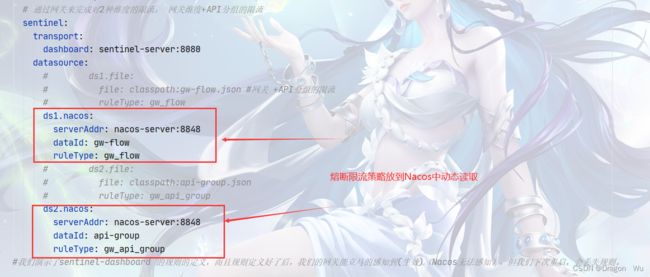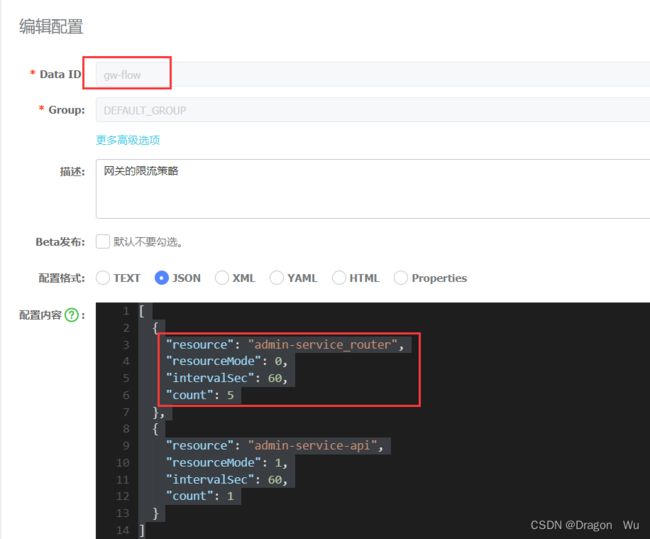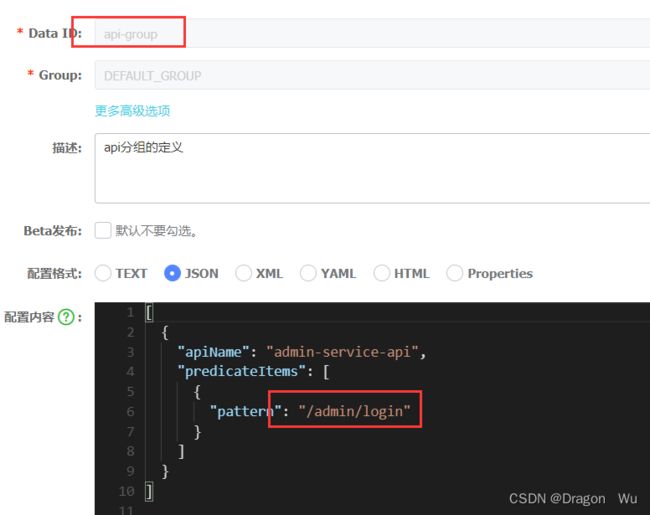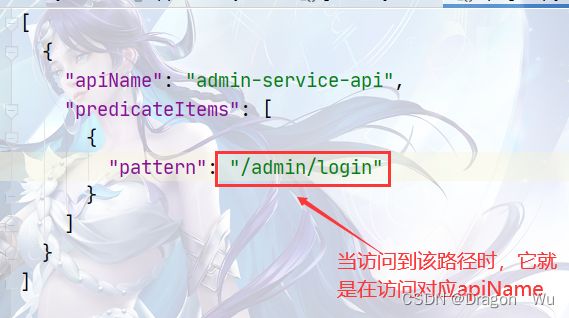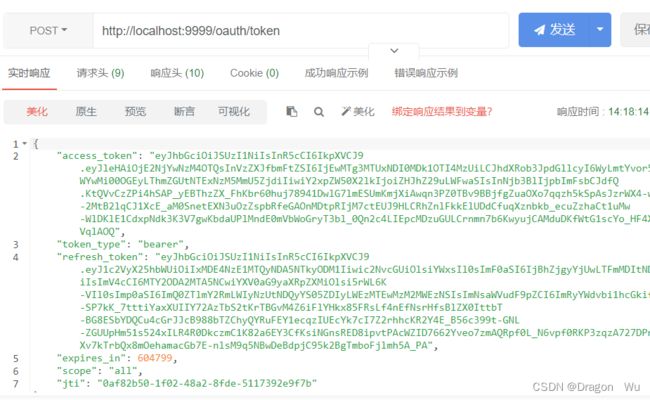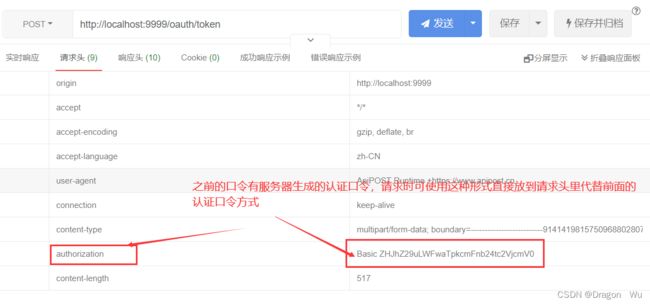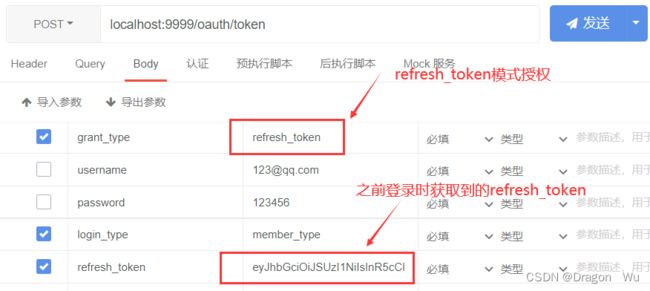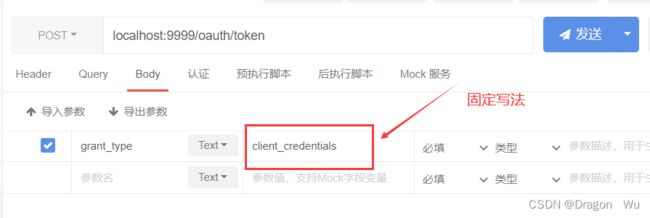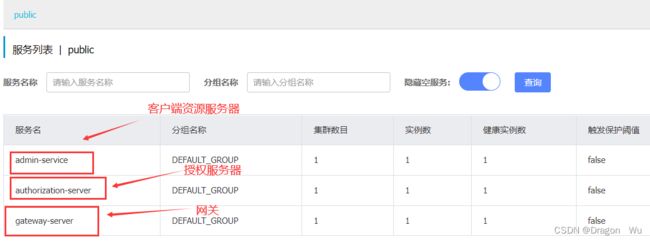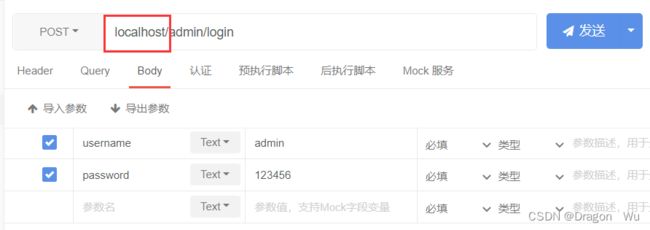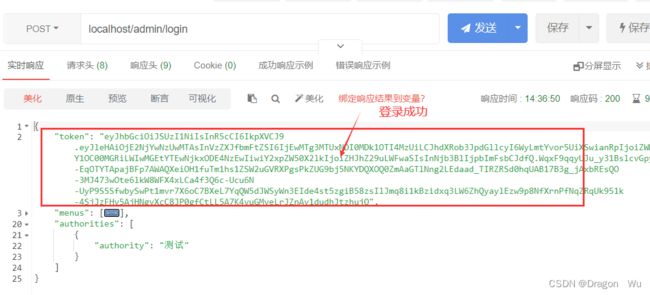微服务 基础服务搭建 Oauth2 Gateway sentinel Nacos JWT OpenFeign 授权登录案例 SpringCloudAlibaba
目录
一、案例源码
二、网关、sentinel熔断限流搭建
1、网关路由
2、网关配置熔断限流策略
3、网关的Token过滤器
二、Oauth2授权服务器搭建
1、生成RSA密钥对
2、授权服务器配置
3、授权登录测试
4、客户端登录
三、最终登录测试
一、案例源码
微服务IASS 网关 sentinel 认证授权中心的搭建模板: 微服务IASS 网关 sentinel 认证授权中心的搭建模板
二、网关、sentinel熔断限流搭建
1、网关路由
将网关和对应微服务注册发现到Nacos中,采用网关负载均衡来路由各个微服务集群。
2、网关配置熔断限流策略
通过网关进行的限流策略有两个维度的限流:
1、网关维度;2、API分组维度的限流
两个维度限流的文件我将其存到Nacos中,便可实现Nacos动态更改熔断限流策略。
要注意的是,虽然熔断限流策略可以被sentinel的可视化操作界面进行动态更改,但更改后的内容也只是缓存在内存里的,若要下次重启仍然保留,需要将该对应的熔断限流策略复制粘贴到,Nacos的对应限流文件里,进行刷新。
网关限流:
测试结果:
通过访问测试我们可以看到,若该路径在API分组策略里,那么该路径会优先执行api分组限流里的策略,否则执行网关的统一限流策略。
3、网关的Token过滤器
授权服务器会给每个微服务在登录成功时授权对应的token,网关需要对这些请求进行判断已筛选出需要token验证的请求。
package com.dragonwu.filter;
import com.alibaba.fastjson.JSONObject;
import org.apache.commons.lang.StringUtils;
import org.apache.http.HttpHeaders;
import org.springframework.beans.factory.annotation.Autowired;
import org.springframework.beans.factory.annotation.Value;
import org.springframework.cloud.gateway.filter.GatewayFilterChain;
import org.springframework.cloud.gateway.filter.GlobalFilter;
import org.springframework.core.Ordered;
import org.springframework.core.io.buffer.DataBuffer;
import org.springframework.data.redis.core.StringRedisTemplate;
import org.springframework.http.HttpStatus;
import org.springframework.http.server.reactive.ServerHttpResponse;
import org.springframework.stereotype.Component;
import org.springframework.web.server.ServerWebExchange;
import reactor.core.publisher.Flux;
import reactor.core.publisher.Mono;
import java.util.Set;
/**
* @author DragonWu
* @since 2022-10-10 12:24
**/
@Component
public class JwtCheckFilter implements GlobalFilter, Ordered {
@Autowired
private StringRedisTemplate redisTemplate;
@Value("${no.require.urls:/admin/login}")
private Set noRequireTokenUris;
/*
过滤器拦截到用户的请求后做啥
*/
@Override
public Mono filter(ServerWebExchange exchange, GatewayFilterChain chain) {
//1: 该接口是否需要token才能访问
if (!isRequireToken(exchange)) {
return chain.filter(exchange);//不需要token,直接放行
}
//2: 若需要token访问,取出用户的token
String token = getUserToken(exchange);
//3:判断用户的token是否有效
if (StringUtils.isEmpty(token)) {
return buildeNoAuthorizationResult(exchange);
}
Boolean hasKey = redisTemplate.hasKey(token);
if (hasKey != null && hasKey) {
return chain.filter(exchange);//token有效,直接放行
}
return buildeNoAuthorizationResult(exchange);
}
/*
给用户响应一个没有token的错误
*/
private Mono buildeNoAuthorizationResult(ServerWebExchange exchange) {
ServerHttpResponse response = exchange.getResponse();
response.getHeaders().set("Content-Type", "application/json");
response.setStatusCode(HttpStatus.UNAUTHORIZED);
JSONObject jsonObject = new JSONObject();
jsonObject.put("error", "NoAuthorization");
jsonObject.put("errorMsg", "Token is Null or Error");
DataBuffer wrap = response.bufferFactory().wrap(jsonObject.toJSONString().getBytes());
return response.writeWith(Flux.just(wrap));
}
/*
从请求头里获取用户的token
*/
private String getUserToken(ServerWebExchange exchange) {
String token = exchange.getRequest().getHeaders().getFirst(HttpHeaders.AUTHORIZATION);
return token == null ? null : token.replace("bearer ", "");
}
/*
判断该接口是否需要token才能访问
*/
private boolean isRequireToken(ServerWebExchange exchange) {
String path = exchange.getRequest().getURI().getPath();
if (noRequireTokenUris.contains(path)) {
return Boolean.FALSE;//不需要token的
}
return Boolean.TRUE;
}
/*
拦截器的顺序
*/
@Override
public int getOrder() {
return 0;
}
}
二、Oauth2授权服务器搭建
1、生成RSA密钥对
密钥对生成见我的这篇文章:
SpringBoot SpringSecurity JWT+Redis+RSA授权登录登出 验证码 前后端分离 分布式_Dragon Wu的博客-CSDN博客
2、授权服务器配置
主要依赖于:
org.springframework.cloud
spring-cloud-starter-oauth2
开启授权服务的配置类:
package com.dragonwu.config;
import org.springframework.beans.factory.annotation.Autowired;
import org.springframework.beans.factory.annotation.Qualifier;
import org.springframework.context.annotation.Configuration;
import org.springframework.core.io.ClassPathResource;
import org.springframework.security.authentication.AuthenticationManager;
import org.springframework.security.core.userdetails.UserDetailsService;
import org.springframework.security.crypto.password.PasswordEncoder;
import org.springframework.security.oauth2.config.annotation.configurers.ClientDetailsServiceConfigurer;
import org.springframework.security.oauth2.config.annotation.web.configuration.AuthorizationServerConfigurerAdapter;
import org.springframework.security.oauth2.config.annotation.web.configuration.EnableAuthorizationServer;
import org.springframework.security.oauth2.config.annotation.web.configurers.AuthorizationServerEndpointsConfigurer;
import org.springframework.security.oauth2.provider.token.TokenStore;
import org.springframework.security.oauth2.provider.token.store.JwtAccessTokenConverter;
import org.springframework.security.oauth2.provider.token.store.JwtTokenStore;
import org.springframework.security.oauth2.provider.token.store.KeyStoreKeyFactory;
/**
* @author DragonWu
* @since 2022-10-10 9:56
**/
@EnableAuthorizationServer //开启授权服务器的功能
@Configuration
public class AuthorizationConfig extends AuthorizationServerConfigurerAdapter {
@Autowired
private PasswordEncoder passwordEncoder;
@Autowired
private AuthenticationManager authenticationManager;
@Autowired
@Qualifier("userServiceDetailsServiceImpl")
private UserDetailsService userDetailsService;
/*
添加第三方的客户端
*/
@Override
public void configure(ClientDetailsServiceConfigurer clients) throws Exception {
clients.inMemory()
.withClient("dragon-api")//第三方客户端的名称
.secret(passwordEncoder.encode("dragon-secret"))//第三方客户端的密钥
.scopes("all")//第三方客户端的授权范围
.authorizedGrantTypes("password", "refresh_token")//密码模式、token刷新模式
.accessTokenValiditySeconds(7 * 24 * 3600)//token的有效期
.refreshTokenValiditySeconds(30 * 24 * 3600)//refresh_token的有效期
.and()
///应用之间内部的访问形式
.withClient("inside-app")
.secret(passwordEncoder.encode("inside-secret"))
.authorizedGrantTypes("client_credentials")//客户端授权,固定写法
.scopes("all")
.accessTokenValiditySeconds(7 * 24 * 3600);
super.configure(clients);
}
/*
配置验证管理器,UserDetailsService
*/
@Override
public void configure(AuthorizationServerEndpointsConfigurer endpoints) throws Exception {
endpoints.authenticationManager(authenticationManager)
.userDetailsService(userDetailsService)
.tokenStore(jwtTokenStore()) //采用JWT存储token
.tokenEnhancer(jwtAccessTokenConverter()); //token转换器
super.configure(endpoints);
}
/*
JWT token 存储
*/
private TokenStore jwtTokenStore() {
return new JwtTokenStore(jwtAccessTokenConverter());
}
/*
JWT转换器
*/
public JwtAccessTokenConverter jwtAccessTokenConverter() {
JwtAccessTokenConverter tokenConverter = new JwtAccessTokenConverter();
//加载我们的私钥
ClassPathResource classPathResource = new ClassPathResource("keys/dragonwu.jks");
KeyStoreKeyFactory keyStoreKeyFactory = new KeyStoreKeyFactory(classPathResource, "dragonwu".toCharArray());//第二个参数为你生成密钥时输入的password
tokenConverter.setKeyPair(keyStoreKeyFactory.getKeyPair("dragonwu", "dragonwu".toCharArray()));//第一个参数是生成密钥是的alias,第二个是password
return tokenConverter;
}
}
Security的配置类:
package com.dragonwu.config;
import org.springframework.context.annotation.Bean;
import org.springframework.context.annotation.Configuration;
import org.springframework.security.authentication.AuthenticationManager;
import org.springframework.security.config.annotation.web.builders.HttpSecurity;
import org.springframework.security.config.annotation.web.configuration.WebSecurityConfigurerAdapter;
import org.springframework.security.crypto.bcrypt.BCryptPasswordEncoder;
import org.springframework.security.crypto.password.PasswordEncoder;
/**
* @author DragonWu
* @since 2022-10-10 10:12
**/
@Configuration
public class WebSecurityConfig extends WebSecurityConfigurerAdapter {
/*
请求说明
*/
@Override
protected void configure(HttpSecurity http) throws Exception {
http.csrf().disable();
http.authorizeRequests().anyRequest().authenticated();
}
/*
认证管理
*/
@Bean
@Override
protected AuthenticationManager authenticationManager() throws Exception {
return super.authenticationManager();
}
/*
加密器
*/
@Bean
public PasswordEncoder passwordEncoder() {
return new BCryptPasswordEncoder();
}
// public static void main(String[] args) {
// PasswordEncoder passwordEncoder=new BCryptPasswordEncoder();
// String encode = passwordEncoder.encode("123456");
// System.out.println(encode);
// }
}
3、授权登录测试
请求成功结果:
用户登录类似,只需要更改对应参数即可:
refresh_token进行刷新登录: 与之前登录类似
服务器内部登录测试:
不同的是内部登录需要采用内部登录时的口令:
4、客户端登录
开启对应的资源服务器
资源服务器配置类:
package com.dragonwu;
import org.springframework.context.annotation.Bean;
import org.springframework.context.annotation.Configuration;
import org.springframework.core.io.ClassPathResource;
import org.springframework.security.config.annotation.method.configuration.EnableGlobalMethodSecurity;
import org.springframework.security.config.annotation.web.builders.HttpSecurity;
import org.springframework.security.oauth2.config.annotation.web.configuration.EnableResourceServer;
import org.springframework.security.oauth2.config.annotation.web.configuration.ResourceServerConfigurerAdapter;
import org.springframework.security.oauth2.config.annotation.web.configurers.ResourceServerSecurityConfigurer;
import org.springframework.security.oauth2.provider.token.TokenStore;
import org.springframework.security.oauth2.provider.token.store.JwtAccessTokenConverter;
import org.springframework.security.oauth2.provider.token.store.JwtTokenStore;
import org.springframework.util.FileCopyUtils;
import java.nio.charset.StandardCharsets;
/**
* @author DragonWu
* @since 2022-10-11 10:14
**/
@Configuration
@EnableGlobalMethodSecurity(prePostEnabled = true) //开启权限访问注解
@EnableResourceServer //开启资源服务器
public class ResourceServerConfig extends ResourceServerConfigurerAdapter {
//允许匿名访问的
private static final String[] ALLOW_ASK = {
"/login",//管理员登录
"/user/login",//用户登录
"/captcha",//验证码
};
//总数允许访问的
private static final String[] ALWAYS_ALLOW_ASK = {
"/v2/api-docs",
"/swagger-resources/configuration/ui",//用来获取支持的动作
"/swagger-resources",//用来获取api-docs的URI
"/swagger-resources/configuration/security",//安全选项
"/webjars/**",
"/swagger-ui.html",//以上为api文档接口访问路径
"**/public/**" //开放访问的资源
};
/*
访问资源配置
*/
@Override
public void configure(HttpSecurity http) throws Exception {
http.csrf()
.disable()
.sessionManagement().disable()
.authorizeRequests()
.antMatchers(ALWAYS_ALLOW_ASK).permitAll()
.antMatchers(ALLOW_ASK).anonymous()
.antMatchers("/**").authenticated()
.and().headers().cacheControl();
}
/*
设置公钥
*/
@Override
public void configure(ResourceServerSecurityConfigurer resources) throws Exception {
resources.tokenStore(jwtTokenStore());
}
/*
jwt token存储
*/
private TokenStore jwtTokenStore() {
return new JwtTokenStore(accessTokenConverter());
}
/*
公钥解密的token转换器
*/
@Bean // 放在ioc容器的
public JwtAccessTokenConverter accessTokenConverter() {
//resource 验证token(公钥) authorization 产生 token (私钥)
JwtAccessTokenConverter tokenConverter = new JwtAccessTokenConverter();
String s = null;
try {
ClassPathResource classPathResource = new ClassPathResource("keys/public.key");
byte[] bytes = FileCopyUtils.copyToByteArray(classPathResource.getInputStream());
s = new String(bytes, StandardCharsets.UTF_8);
} catch (Exception ignored) {
}
tokenConverter.setVerifierKey(s);
return tokenConverter;
}
}
从代码中我们也不难看出,授权服务器拥有私钥可以对JWT token进行生成,而客户端志愿服务器仅有公钥对JWT token进行解密。
客户端访问授权服务器采用OpenFeign来访问
package com.dragonwu.feign;
import com.fasterxml.jackson.annotation.JsonProperty;
import lombok.Data;
/**
* @author DragonWu
* @since 2022-10-11 8:48
**/
@Data
public class JwtToken {
@JsonProperty("access_token")
private String accessToken;
/*
token的类型
*/
@JsonProperty("token_type")
private String tokenType;
@JsonProperty("refresh_token")
private String refreshToken;
/*
过期时间
*/
@JsonProperty("expires_in")
private Long expiresIn;
/*
token的范围
*/
private String scope;
/*
颁发的凭证
*/
private String jti;
}
Feign接口
package com.dragonwu.feign;
import org.springframework.cloud.openfeign.FeignClient;
import org.springframework.http.ResponseEntity;
import org.springframework.web.bind.annotation.PostMapping;
import org.springframework.web.bind.annotation.RequestHeader;
import org.springframework.web.bind.annotation.RequestParam;
/**
* @author DragonWu
* @since 2022-10-11 8:52
**/
@FeignClient(value = "authorization-server")
public interface OAuth2FeignClient {
@PostMapping("/oauth/token")
ResponseEntity getToken(
@RequestParam("grant_type") String grantType,//授权类型
@RequestParam("username") String username,//用户名
@RequestParam("password") String password,//用户密码
@RequestParam("login_type") String loginType,//登录的类型
@RequestHeader("authorization") String basicToken//Basic ZHJhZ29uLWFwaTpkcmFnb24tc2VjcmV0 由第三方加密出来的值
);
}
登录实现类:
package com.dragonwu.service.impl;
import com.alibaba.fastjson2.JSON;
import com.alibaba.fastjson2.JSONArray;
import com.alibaba.fastjson2.JSONObject;
import com.dragonwu.entity.SysMenu;
import com.dragonwu.feign.JwtToken;
import com.dragonwu.feign.OAuth2FeignClient;
import com.dragonwu.model.LoginResult;
import com.dragonwu.service.ISysMenuService;
import com.dragonwu.service.SysLoginService;
import org.springframework.beans.factory.annotation.Autowired;
import org.springframework.beans.factory.annotation.Value;
import org.springframework.http.HttpStatus;
import org.springframework.http.ResponseEntity;
import org.springframework.security.core.authority.SimpleGrantedAuthority;
import org.springframework.security.jwt.Jwt;
import org.springframework.security.jwt.JwtHelper;
import org.springframework.stereotype.Service;
import java.util.List;
import java.util.stream.Collectors;
/**
* @author DragonWu
* @since 2022-10-11 8:42
**/
@Service
public class SysLoginServiceImpl implements SysLoginService {
@Autowired
private OAuth2FeignClient oAuth2FeignClient;
@Value("${basic.token:Basic ZHJhZ29uLWFwaTpkcmFnb24tc2VjcmV0}")
private String basicToken;
@Autowired
private ISysMenuService sysMenuService;
@Override
public LoginResult login(String username, String password) throws RuntimeException{
System.out.println("用户:"+username+"开始登录...");
//1、获取token 远程调用authorization-server 的该服务
ResponseEntity tokenResponseEntity = oAuth2FeignClient.getToken("password", username, password, "admin_type", basicToken);
if(tokenResponseEntity.getStatusCode()!= HttpStatus.OK){
throw new RuntimeException("token获取失败");
}
JwtToken jwtToken=tokenResponseEntity.getBody();
System.out.println("远程调用授权服务器成功,获取的token为:"+ JSON.toJSONString(jwtToken));
assert jwtToken != null;
String token=jwtToken.getAccessToken();
//2、查询我们的菜单数据
Jwt jwt= JwtHelper.decode(token);//解析jwt
String jwtJsonStr=jwt.getClaims();//获得解析后的数据
JSONObject jwtJson=JSON.parseObject(jwtJsonStr);//将解析后的数据转为json格式
Long userId=Long.valueOf(jwtJson.getString("user_name"));//json中的user_name就是之前登录时存入的用户id
List menus=sysMenuService.getMenuByUserId(userId);//通过用户id获取到对应的菜单
//3、权限数据怎么查询-->不需要查询的,因为我们的jwt里面已包含了
JSONArray authoritiesJsonArray=jwtJson.getJSONArray("authorities");
List authorities=authoritiesJsonArray.stream()//组装我们的权限数据
.map(authorityJson->new SimpleGrantedAuthority(authorityJson.toString()))
.collect(Collectors.toList());
return new LoginResult(token,menus,authorities);
}
}
三、最终登录测试
可以看到次时我们通过网关去访问admin-service的login接口,admin-service此时做资源服务器,通过authorization-server进行授权登录。
请求路线:
url-->gateway-->admin-service-->authorization-server
--授权成功,颁发token-->admin-service-->响应。
案例见代码,后续还会优化代码。

